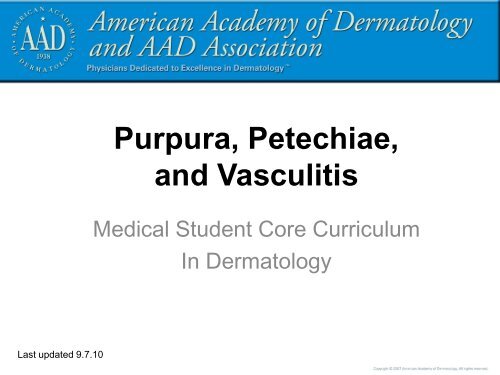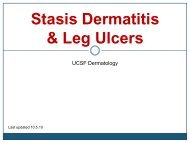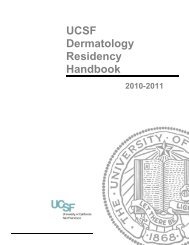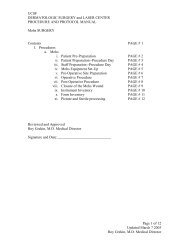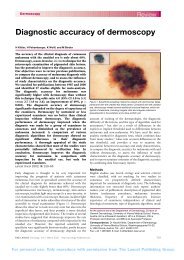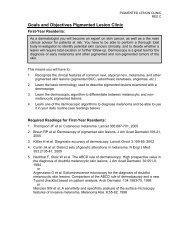Purpura, Petechiae, and Vasculitis - Dermatology
Purpura, Petechiae, and Vasculitis - Dermatology
Purpura, Petechiae, and Vasculitis - Dermatology
Create successful ePaper yourself
Turn your PDF publications into a flip-book with our unique Google optimized e-Paper software.
Last updated 9.7.10<br />
<strong>Purpura</strong>, <strong>Petechiae</strong>,<br />
<strong>and</strong> <strong>Vasculitis</strong><br />
Medical Student Core Curriculum<br />
In <strong>Dermatology</strong>
Module Instructions<br />
The following module contains a number<br />
of blue, underlined terms which are<br />
hyperlinked to the dermatology glossary,<br />
an illustrated interactive guide to clinical<br />
dermatology <strong>and</strong> dermatopathology.<br />
We encourage the learner to read all the<br />
hyperlinked information.
Goals <strong>and</strong> Objectives<br />
The purpose of this module is to help medical students<br />
develop a clinical approach to the initial evaluation <strong>and</strong><br />
treatment of patients with petechiae <strong>and</strong> purpura.<br />
After completing this module, the medical student will be<br />
able to:<br />
• Identify <strong>and</strong> describe the morphology of petechiae <strong>and</strong> purpura<br />
• Outline an initial diagnostic approach to petechiae or purpura<br />
• Recognize patterns of petechiae that are concerning for lifethreatening<br />
conditions<br />
• Recognize palpable purpura as the hallmark lesion of<br />
leukocytoclastic vasculitis<br />
• Name the common etiologies of vasculitides according to size of<br />
vessel affected
<strong>Purpura</strong>: The Basics<br />
The term <strong>Purpura</strong> is used to describe red-purple lesions<br />
that result from the extravasation of blood into the skin or<br />
mucous membranes<br />
<strong>Purpura</strong> may be palpable or non-palpable (flat/macular)<br />
Macular purpura is divided into two morphologies based<br />
on size:<br />
• <strong>Petechiae</strong>: small lesions (< 3 mm)<br />
• Ecchymoses: larger lesions (>5mm)<br />
The type of lesion present is usually indicative of the<br />
underlying pathogenesis:<br />
• Macular purpura is typically non-inflammatory<br />
• Palpable purpura is a sign of vascular inflammation<br />
(vasculitis)
<strong>Purpura</strong>: The Basics<br />
All forms do not blanch when pressed<br />
• Diascopy refers to the use of a glass slide to<br />
apply pressure to the lesion, which can be useful<br />
in distinguishing erythema secondary to<br />
vasodilation (blanchable with pressure), from<br />
erythrocyte extravasation (retains its red color)<br />
<strong>Purpura</strong> may result from hyper- <strong>and</strong> hypocoagulable<br />
states, vascular dysfunction <strong>and</strong><br />
extravascular causes
Examples of <strong>Purpura</strong><br />
Petechia<br />
Ecchymosis
Examples of <strong>Purpura</strong><br />
Ecchymoses<br />
<strong>Petechiae</strong>
Case One<br />
Mr. Chad Fields
Case One: History<br />
HPI: Mr. Fields is a 42 year-old gentleman who presents to<br />
the ER with a 2-week history of a rash on his abdomen<br />
<strong>and</strong> lower extremities.<br />
PMH: hospitalization 1 year ago for community acquired<br />
pneumonia<br />
Medications: none<br />
Allergies: none<br />
Family History: unknown<br />
Social History: marginally housed, no recent travel or<br />
exposure to animals<br />
Health Related Behaviors: smokes 10 cigarettes/day,<br />
drinks 3-10 beers/day, limited access to food<br />
ROS: easy bruising, bleeding from gums, overall fatigue
Case One: Exam<br />
Perifollicular petechiae<br />
Keratotic plugging of hair<br />
follicles
Case One: Exam<br />
Mr. Fields also has<br />
hemorrhagic gingivitis
Case One, Question 2<br />
Which of the following is the most likely<br />
diagnosis?<br />
a. drug hypersensitivity reaction<br />
b. urticaria<br />
c. vasculitis<br />
d. rocky mountain spotted fever<br />
e. nutritional deficiency
Case One, Question 2<br />
Answer: e<br />
Which of the following is the most likely<br />
diagnosis?<br />
a. drug hypersensitivity reaction (typically without<br />
purpuric lesions)<br />
b. urticaria (would expect raised edematous lesions, not<br />
purpura)<br />
c. vasculitis (purpura would not be perifollicular <strong>and</strong><br />
would be palpable)<br />
d. rocky mountain spotted fever (no history of travel or<br />
tick bite)<br />
e. nutritional deficiency
Vitamin C Deficiency - Scurvy<br />
Scurvy results from insufficient vitamin C intake (i.e. fad<br />
diet, alcoholism), increased vitamin requirement (i.e.<br />
certain medications), <strong>and</strong> increased loss (i.e. dialysis)<br />
Vitamin C is required for normal collagen structure <strong>and</strong> its<br />
absence leads to skin <strong>and</strong> vessel fragility<br />
Characteristic exam findings include:<br />
• perifollicular purpura<br />
• large ecchymoses on the lower legs<br />
• intramuscular <strong>and</strong> periosteal hemorrhage<br />
• keratotic plugging of hair follicles<br />
• hemorrhagic gingivitis (when patient has poor oral hygeine)<br />
Remember to take a dietary history in all patients with<br />
purpura
Case Two<br />
Mr. Andrew Thompson
Case Two: History<br />
HPI: Andrew is a 19 year-old gentleman who was admitted to the<br />
hospital with a headache, stiff neck, high fever, <strong>and</strong> a rash. His<br />
symptoms began 2-3 days prior to admission when he developed<br />
fevers with nausea <strong>and</strong> vomiting.<br />
PMH: splenectomy 3 years ago after a snowboarding accident<br />
Medications: none<br />
Allergies: none<br />
Vaccination hx: last vaccination as a child<br />
Family history: not contributory<br />
Social history: attends a near-by state college, lives in a dormitory<br />
Health related behaviors: reports occasional alcohol use on the<br />
weekends with 2-3 drinks per night, plays basketball with friends for<br />
exercise.<br />
ROS: as mentioned in HPI
Case Two: Exam<br />
Vitals: T 102.4 ºF, HR 120, BP<br />
86/40, RR 20, O2 sat 96% on<br />
room air<br />
Gen: ill-appearing male lying on<br />
a gurney<br />
HEENT: PERRL, EOMI, + nuchal<br />
rigidity<br />
Skin: petechiae <strong>and</strong> large<br />
ecchymotic patches on upper<br />
(not shown) <strong>and</strong> lower<br />
extremities = <strong>Purpura</strong> fulminans
Case Two: Initial Labs<br />
• WBC count:14,000 cells/mcL<br />
• Platelets: 100,000/mL<br />
• Decreased fibrinogen<br />
• Increased PT, PTT<br />
• Blood Culture: gram negative diplococci<br />
• Lumbar puncture: pending
Case Two, Question 1<br />
In addition to fluid resuscitation, what is<br />
the most needed treatment at this time?<br />
a. Plasmapheresis<br />
b. IV antibiotics<br />
c. Pain relief with oxycodone<br />
d. IV corticosteroids
Case Two, Question 1<br />
Answer: b<br />
• In addition to fluid resuscitation, what is the most<br />
needed treatment at this time?<br />
a. Plasmaphoresis (not unless suspecting diagnosis<br />
of TTP)<br />
b. IV antibiotics (may be started before lumbar<br />
puncture)<br />
c. Pain relief with oxycodone (not the patient’s<br />
primary issue)<br />
d. IV corticosteroids (not unless suspicion for<br />
pneumococcal meningitis is high)
Sepsis <strong>and</strong> DIC<br />
Andrew’s clinical picture is concerning for<br />
meningococcemia with disseminated intravascular<br />
coagulation (DIC)<br />
Presence of petechial or purpuric lesions in the patient<br />
with meningitis should raise concern for sepsis <strong>and</strong> DIC<br />
Neisseria meningitis is a gram negative diplococcus that<br />
causes meningococcal disease<br />
• Most common presentations are meningitis <strong>and</strong><br />
meningococcemia<br />
DIC results from unregulated intravascular clotting<br />
resulting in depletion of clotting factors <strong>and</strong> bleeding<br />
• The primary treatment is always to treat the underlying<br />
condition
Rocky Mountain Spotted Fever<br />
Another life-threatening diagnosis to consider in a patient<br />
with a petechial rash is Rocky Mountain Spotted Fever<br />
(RMSF)<br />
The most commonly fatal tickborne infection (caused by<br />
Rickettsia rickettsii) in the US<br />
A petechial rash is a frequent finding that usually occurs<br />
several days after the onset of fever<br />
Initial appearance of the rash is characterized by faint<br />
macules on the wrists or ankles. As the disease<br />
progresses, the rash may become petechial <strong>and</strong> involves<br />
the trunk, extremities, palms <strong>and</strong> soles<br />
Majority of patients do not have the classic triad of fever,<br />
rash <strong>and</strong> history of tick bite
Clinical Evaluation of <strong>Purpura</strong><br />
A history <strong>and</strong> physical exam is often all that is<br />
necessary<br />
Important history items include:<br />
• Family history of bleeding or thrombotic disorders (ie von<br />
Willebr<strong>and</strong> disease)<br />
• Use of drugs <strong>and</strong> medications (i.e. aspirin, warfarin) that<br />
may affect platelet function <strong>and</strong> coagulation<br />
• Medical conditions (i.e. liver disease) that may result in<br />
altered coagulation<br />
Complete blood count with differential <strong>and</strong> PT/PTT<br />
are used to help assess platelet function <strong>and</strong><br />
evaluate coagulation states
Causes of Non-Palpable <strong>Purpura</strong><br />
<strong>Petechiae</strong><br />
• Thrombocytopenia<br />
• Idiopathic<br />
• Drug-induced<br />
• Thrombotic<br />
• DIC <strong>and</strong> infection<br />
• Abnormal platelet function<br />
• Increased intravascular<br />
venous pressures<br />
• Some inflammatory skin<br />
diseases<br />
Ecchymoses<br />
• External trauma<br />
• DIC <strong>and</strong> infection<br />
• Coagulation defects<br />
• Skin weakness/fragility<br />
• Waldenstrom<br />
hypergammaglobulinnemic<br />
purpura
Palpable <strong>Purpura</strong><br />
Palpable purpura results from inflammation of<br />
small cutaneous vessels, ie vasculitis<br />
Vessel inflammation results in vessel wall damage<br />
<strong>and</strong> in extravasation of erythrocytes seen as<br />
purpura on the skin<br />
<strong>Vasculitis</strong> may occur as a primary process or may<br />
be secondary to another underlying disease<br />
Palpable purpura is the hallmark lesion of<br />
leukocytoclastic vasculitis (small vessel vasculitis)
<strong>Vasculitis</strong> Morphology<br />
<strong>Vasculitis</strong> is classified by the vessel size affected (small,<br />
medium, mixed size or large)<br />
Clinical morphology correlates with the size of the affected<br />
blood vessels<br />
• Small vessel: palpable purpura (urticarial lesions in rare cases, ie<br />
urticarial vasculitis)<br />
• Small-to medium-sized vessels: subcutaneous nodules, purpura <strong>and</strong><br />
FIXED livedo reticularis (also called livedo racemosa)<br />
• Large-vessel disease: claudication, ulceration <strong>and</strong> necrosis<br />
Diseases may involve more than one size of vessel<br />
Systemic vasculitis may involve vessels in other organs
Vasculitides According to Size of the<br />
Blood Vessels<br />
Small vessel vasculitis (leukocytoclastic vasculitis)<br />
• Henoch-Schonlein purpura<br />
• Urticarial vasculitis<br />
• Other:<br />
• Idiopathic<br />
• Malignancy-related<br />
• Rheumatologic<br />
• Infection<br />
• Medication
Vasculitides According to Size of the<br />
Blood Vessels<br />
Predominantly Mixed (Small + Medium)<br />
• ANCA associated vasculitides<br />
• Churg-Strauss syndrome<br />
• Wegener granulomatosis<br />
• Microscopic polyarteritis<br />
• Essential cryoglobulinemic vasculitis<br />
Predominantly medium sized vessels<br />
• Polyarteritis nodosa<br />
Predominantly large vessels<br />
• Takayasu arteritis<br />
• Giant cell arteritis
Clinical Evaluation of <strong>Vasculitis</strong><br />
The following laboratory tests may be used to evaluate<br />
patient with suspected vasculitis:<br />
• CBC with platelets<br />
• ESR (systemic vasculitides tend to have sedimentation rates > 50)<br />
• ANA (a positive antinuclear antibody test suggests the presence of<br />
an underlying connective tissue disorder)<br />
• ANCA (help diagnose Wegener granulomatosis, microsopic<br />
polyarteritis, drug-induced vasculitis, <strong>and</strong> Churg-Strauss)<br />
• Complement (low serum complement levels may be present in<br />
mixed cryoglobulinemia, urticarial vasculitis <strong>and</strong> lupus)<br />
• Urinalysis (helps detect renal involvement)<br />
Also consider ordering cryoglobulins, an HIV test, HBV <strong>and</strong><br />
HCV serology, occult stool samples, an ASO titer <strong>and</strong><br />
streptococcal throat culture
Case Three<br />
Jenny Miller
Case Three: History<br />
HPI: Jenny is a 9 year-old girl with a 4-day history of abdominal<br />
pain <strong>and</strong> rash on the lower extremities who was brought to the<br />
ER by her mother. Her mother reported that the rash appeared<br />
suddenly <strong>and</strong> was accompanied by joint pain of the knees <strong>and</strong><br />
ankles <strong>and</strong> aching abdominal pain. Over 3 days the rash<br />
changed from red patches to more diffuse purple bumps.<br />
PMH: normal birth history, no major illnesses or hospitalizations<br />
Medications: none, up to date on vaccines<br />
Allergies: none<br />
Family History: no history of clotting or bleeding disorders<br />
Social History: happy child when feeling well, attends school,<br />
takes ballet<br />
ROS: cough <strong>and</strong> runny nose a few weeks ago
Case Three: Exam<br />
Non-blanching erythematous<br />
macules <strong>and</strong> papules on both<br />
legs <strong>and</strong> feet sparing the<br />
trunk, upper extremities <strong>and</strong><br />
face, diffuse petechiae
Case Three, Question 1<br />
In this clinical context, what test will establish<br />
the diagnosis?<br />
a. HIV test<br />
b. CBC<br />
c. ESR<br />
d. Urinalysis<br />
e. Skin biopsy for routine microscopy <strong>and</strong> direct<br />
immunofluorescence
Answer: e<br />
Case Three, Question 1<br />
In this clinical context, what test will establish the<br />
diagnosis?<br />
a. HIV test<br />
b. CBC<br />
c. ESR<br />
d. Urinalysis<br />
e. Skin biopsy for routine microscopy <strong>and</strong> direct<br />
immunofluorescence
Skin Biopsy<br />
• A skin biopsy obtained from a new<br />
purpuric lesion reveals a leukocytoclastic<br />
vasculitis of the small dermal blood<br />
vessels<br />
• Direct immunofluorescence demonstrates<br />
perivascular IgA, C3 <strong>and</strong> fibrin deposits<br />
• A skin biopsy is often necessary to<br />
establish the diagnosis of vasculitis
Case Three, Question 2<br />
What is the most likely diagnosis?<br />
a. Urticaria<br />
b. Disseminated intravascular coagulation<br />
c. Henoch-Schonlein <strong>Purpura</strong><br />
d. Idiopathic thrombocytopenic purpura<br />
e. Sepsis
Answer: c<br />
Case Three, Question 2<br />
What is the most likely diagnosis?<br />
a. Urticaria<br />
b. Disseminated intravascular coagulation<br />
c. Henoch-Schonlein <strong>Purpura</strong><br />
d. Idiopathic thrombocytopenic purpura<br />
e. Sepsis
Henoch Schonlein <strong>Purpura</strong><br />
Henoch Schonlein <strong>Purpura</strong> (HSP) is the most<br />
common form of systemic vasculitis in children<br />
Primarily a childhood disease (between ages 3-<br />
15), but adults can also be affected<br />
HSP follows a seasonal pattern with a peak in<br />
incidence during the winter presumably due to<br />
association with a preceding viral or bacterial<br />
infection<br />
Characterized by palpable purpura (vasculitis),<br />
arthritis, abdominal pain <strong>and</strong> kidney disease
HSP: Diagnosis <strong>and</strong> Evaluation<br />
Diagnosis often made on clinical presentation +/skin<br />
biopsy<br />
Skin biopsy shows leukocytoclastic vasculitis in<br />
postcapillary venules (small vessel disease)<br />
• Immune complexes in vessel walls contain IgA<br />
deposition (the diagnostic feature of HSP)<br />
Rule out streptococcal infection with an ASO or<br />
throat culture
HSP: Evaluation <strong>and</strong> Treatment<br />
Also important to look for systemic disease:<br />
• Renal: Urinalysis, BUN/Cr<br />
• Gastrointestinal: Stool guaiac<br />
• HSP in adults may be a manifestation of underlying<br />
malignancy<br />
Natural History: most children completely<br />
recover from HSP<br />
Some develop progressive renal disease (more<br />
common in adults)<br />
Treatment is supportive +/- prednisone
Take Home Points<br />
<strong>Petechiae</strong> <strong>and</strong> Macular <strong>Purpura</strong><br />
The term purpura is used to describe purpuric lesions<br />
that result from extravasation of blood into the skin or<br />
mucous membranes<br />
<strong>Purpura</strong> may be palpable <strong>and</strong> non-palpable<br />
<strong>Purpura</strong> does not blanch with pressure<br />
Various life-threatening conditions present with petechial<br />
rashes including meningococcemia <strong>and</strong> RMSF<br />
The presence of petechial or purpuric lesions in a septic<br />
patient should raise concern for DIC<br />
<strong>Purpura</strong> may result from hyper- <strong>and</strong> hypocoagulable<br />
states, vascular dysfunction <strong>and</strong> exrtravascular causes
Take Home Points<br />
<strong>Vasculitis</strong><br />
Palpable purpura results from underlying blood<br />
vessel inflammation (vasculitis)<br />
Palpable purpura is the hallmark lesion of<br />
leukocytoclastic vasculitis<br />
The various etiologies of vasculitis may be<br />
categorized according to size of vessel affected<br />
A skin biopsy is often necessary for the<br />
diagnosis of vasculitis
End of Module<br />
Dedeoglu F, Kim S, Sundel R. Management of Henoch-Schönlein purpura. Uptodate.com. June<br />
2010.<br />
Dedeoglu F, Kim S, Sundel R. Clinical manifestations <strong>and</strong> diagnosis of Henoch-Schönlein purpura.<br />
Uptodate.com. June 2010.<br />
Fatal Cases of Rocky Mountain Spotted Fever in Family Clusters --- Three States, 2003. MMWR<br />
Weekly May 21, 2004/53(19);407-410.<br />
Gota Carmen E, M<strong>and</strong>ell Brian F, "Chapter 165. Systemic Necrotizing <strong>Vasculitis</strong>" (Chapter). Wolff K,<br />
Goldsmith LA, Katz SI, Gilchrest B, Paller AS, Leffell DJ: Fitzpatrick's <strong>Dermatology</strong> in General<br />
Medicine, 7e: http://www.accessmedicine.com/content.aspx?aID=2993241.<br />
Hunder GG. Treatment of giant cell (temporal) arteritis. Uptodate.com. June 2008.<br />
Hunder GG. Classification of <strong>and</strong> approach to the vasculitides in adults. Uptodate.com. May 2008.<br />
James WD, Berger TG, Elston DM, “Chapter 35. Cutaneous Vascular Diseases” (chapter). Andrews’<br />
Diseases of the Skin Clinical <strong>Dermatology</strong>. 10 th ed. Philadelphia, Pa: Saunders Elsevier; 2006: 820-<br />
845.<br />
Rashid Bina A, Houshm<strong>and</strong> Elizabeth B, Heffernan Michael P, "Chapter 145. Hematologic Diseases"<br />
(Chapter). Wolff K, Goldsmith LA, Katz SI, Gilchrest B, Paller AS, Leffell DJ: Fitzpatrick's<br />
<strong>Dermatology</strong> in General Medicine, 7e: http://www.accessmedicine.com/content.aspx?aID=2989841.<br />
Rosenstein NE, Perkins BA, Stephens DS, Popovic T, Hughes JM. Meningococcal Disease. Review<br />
Article. N Endl J Med. 2001;344:1378-1388.<br />
The <strong>Dermatology</strong> Glossary, http://missinglink.ucsf.edu/lm/<strong>Dermatology</strong>Glossary/index.html


